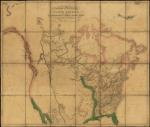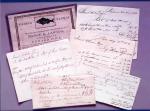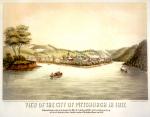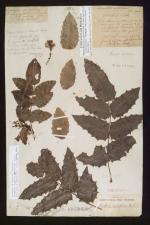Chapter Two: Setting Out
As Meriwether Lewis prepared in Philadelphia during the spring of 1803 for his great expedition across the North American continent, no American knew how far a boat could go up the Missouri River. No one knew what rapids he and his volunteers would shoot or what falls they would have to portage. No American east of the Mississippi had yet seen the Rocky Mountains, let alone navigated their passes.
Lewis had no means of knowing what Native American tribes he would encounter or how they would greet his expedition. And no one - not Thomas Jefferson, not Meriwether Lewis, and not William Clark - knew how far or how long these explorers would have to travel to reach the Pacific Ocean and then return. Mere estimates - some educated, mostly not - were all that Meriwether Lewis had as he made his plans and assembled his supplies.
In order to assist Lewis, the government opened its storehouses at the Harpers Ferry Arsenal in Virginia and the
When Lewis arrived in Philadelphia during the second week of May 1803, the expedition was still a well-kept secret, known to only a few as essentially a military foray into foreign territory. Lewis had two objectives during this visit to Philadelphia: to study with the brightest scientists of the day, and to shop for supplies. In this city of 81,000, Lewis found his choice of importers, merchants, and manufacturers. Israel Whelan, the experienced Purveyor of Public Supplies who was a former confidant of Gen. Washington, assisted Lewis with his purchases. Together, they sorted through the merchandise of dozens of Philadelphia's shops, identifying 200 types of articles that would fill thirty-five boxes. In all, they packed more than a ton and a half of supplies into the Expedition's Conestoga wagon before it rolled out of Philadelphia on June 10th 1803, headed to the western staging point for the start of the Expedition in Pittsburgh.
Generally, Whelan improved on Lewis' guesses as to what might be needed to sustain the Corps of Discovery through the unknown and back again. But just for good measure, President Thomas Jefferson also handed Lewis a letter before he officially departed that gave him the authority to purchase or barter for anything that he might deem useful or necessary along the way. Although Lewis never put that letter to use, he did continue to spend as needed. When Lewis added up all of his 1,989 receipts at the end of the expedition, the final cost for the twenty-eight month, 8,000-mile trek was $38,722.35 - far more than the original $2,500 allocation from Congress. The U.S. government eventually picked up the tab for the entire Expedition.
When he had finished shopping and studying in Philadelphia, Lewis traveled back to Washington, where he stayed until July 5th, the day after the public announcement of the Louisiana Purchase. As word of the Expedition became public, Lewis left the Capital and traveled to Pittsburgh where he would pack his supplies onto a keelboat that he had ordered built for the trip, and begin to recruit volunteers. On the way, he stopped in Harpers Ferry to check that the supplies shipped earlier had arrived - and to find that the first wagon driver had left some behind–then made his way to Pittsburgh.
There he would load the supplies brought by wagon from Philadelphia onto a keelboat of his own design, and meet with Lt. Moses Hooke, commander of
Finally, at 10 a.m. on August 31st 1803, Lewis and a crew of eleven, including seven army recruits from Carlisle, launched the keelboat, a smaller, flat-bottomed vessel called a pirogue, and perhaps a large canoe into the dangerously low Ohio River. The first day did not go well, for the volunteers did not know how to work with each other on the river. Three miles below the launch, Lewis made a brief stop to inspect the caulking of the keelboat.
There he also demonstrated his pneumatic rifle, an experimental air gun that he had borrowed from its inventor, Isaiah Lukens, in Philadelphia. Lewis fired the smokeless, silent weapon several times before passing it to Pittsburgh resident Blaze Cenas, who accidentally shot a woman standing forty yards away. The metal ball grazed her temple and she fell to the ground, blood gushing from her head. The woman survived - to Lewis' "enespreeable [inexpressible] satisfaction" - and the Expedition returned to the river.
After another mile, the keelboat had to be maneuvered over a sandbar, or "riffle" as Lewis called it, for about thirty yards. A short distance down river they encountered another "riffle," and then another. Three times the crew would have to unload the contents of the keelboat into the pirogue and drag the 55-foot boat over the sandbars. At the end of first day of the expedition, Lewis and his men had traveled only ten, very laborious miles.
Later during the expedition, Clark described the small, well-stocked fleet: "All our provisions, goods and equipage on Board of the Boat of 22 oars, a large Perogue of 7 oares a Second Perogue of 6 oars, Complete with Sails, with Powder Cartridges and 100 Balls each, all in health and readiness to Set out. Boats and every thing Complete, with the necessary Stores of provisions and such articles of merchendize as we thought ourselves autherised to percure - though not as much as I think necessy for the multitude of Indians through which we must pass on our road across the Continent…"
Lewis and Clark's men navigated the Pittsburgh keelboat 1,600 miles up the Missouri River, from Saint Louis to what is now west central North Dakota. There, among the Mandan and Hidatsa Indians, they stayed through the winter in a fort they built themselves and called Ford Mandan. In April 1805, the main body of the Expedition prepared to set off for the Continental Divide. To reach the Pacific Ocean, they would first have to travel more than 140 miles over mountains frequently covered with snow.
At this point, Corporal Richard Warfington returned to Saint Louis with eight men (including a few of the problem volunteers in the Corps) and a keelboat filled with Expedition discoveries and documents that included journals with descriptions of the first twenty months of the Expedition, Indian artifacts, plant and zoological specimens, four live magpies, a prairie dog, and a prairie sharp-tailed grouse.
An ecstatic Jefferson received this shipment in mid-July 1805. He displayed some of the artifacts in the main hall at Monticello and sent others to the Peale Museum in Philadelphia. And then, for a very long and silent fourteen months, no one heard another word from anyone in the Expedition. Jefferson, as well as the rest of the nation, had no choice but to wait anxiously for news from the Corps of Discovery as the Expedition continued.













